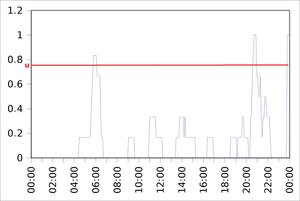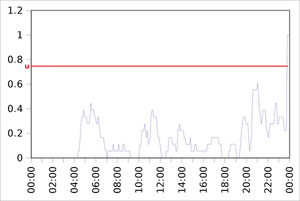Activity monitoring for seniors living alone
Conclusions
So far, Seheiah has only been installed and tested in two households. The tests showed that a regular daily schedule is the most important factor for reliably detecting falls and that you need to experiment with the threshold values (Figures 5-7).
 Figure 6: On half of the weekends, the senior was on the road, without saying "bye bye." The probability of a fall being detected is only guaranteed in the early morning, late evening, or at night.
Figure 6: On half of the weekends, the senior was on the road, without saying "bye bye." The probability of a fall being detected is only guaranteed in the early morning, late evening, or at night.
 Figure 7: On a weekday, a whole day might pass in the worst case before the subject is detected. In this case, the intervals and threshold values need some serious adjustment.
Figure 7: On a weekday, a whole day might pass in the worst case before the subject is detected. In this case, the intervals and threshold values need some serious adjustment.
Falls are detected promptly if they occur immediately before a regularly recurring event (e.g., a regular nightly visit to the bathroom) or if they are accompanied by unusually high water consumption (e.g., a slip in the shower).
If a senior falls when leaving the shower or at night when returning from the bathroom to the bed, it could take several hours in the worst case before Seheiah detected the fall. This situation does not help to prevent a "long lie." In the best case, the victim is still conscious, still has a clear voice and clear pronunciation, and can instruct Seheiah to send a call for help.
Infos
- "Population Structure and Ageing," Eurostat, 2012: http://epp.eurostat.ec.europa.eu/statistics_explained/0index.php/Population_structure_and_ageing
- AgingStats.gov: http://www.agingstats.gov/Main_Site/Data/2012_Documents/Population.aspx
- "People living alone in Germany, results of the micro-census 2011," Federal Statistical Office: https://www.destatis.de/DE/Publikationen/Thematisch/Bevoelkerung/HaushalteMikrozensus/AlleinlebendeInDeutschlandPresse.html (in German)
- "Epidemiology of Falls" by Tahir Masud and Robert O. Morris, Age and Ageing 30(4), pg. 37, November 2001
- "A Global Report on Falls Prevention: Epidemiology of Falls" by Sachiyo Yoshida, World Health Organization, 2007: http://www.who.int/ageing/projects/1.Epidemiology%20of%20falls%20in%20older%20age.pdf
- "Risk factors for serious injury during falls by older persons in the community" by Tinetti et al., Journal of the American Geriatrics Society 43(11), pg. 1214-1221, November 1995
- "Persons Found in Their Homes Helpless or Dead" by R. Jan Gurley et al. The New England Journal of Medicine 334(26), pg. 1710-1716, June 1996
- "Falls in the elderly: Detection and assessment" by Lord and Colin, Proceedings of the Annual International Conference of the IEEE, pg. 1938-1939, November 1991
- "Fall detection – Principles and methods" by N. Noury et al., Proceedings of the 29th Annual International Conference of the IEEE Engineering in Medicine and Biology Society, August 2007: ftp://ftp.prip.tuwien.ac.at/pub/outgoing/zamba/fallpapers/Noury07.pdf
- "Introducing a low-cost ambient monitoring system for activity recognition" S. Chiriac et al., Proceedings of the 5th International Conference on Pervasive Computing Technologies for Healthcare (PervasiveHealth), pg. 340-345, May 2011
- "Zur Entwicklung der Altersarmut in Deutschland" (On the development of old-age poverty in Germany) by Goebel and Grabka, Weekly report by DIW Berlin 25, pg. 316, 2011 (in German)
- "Die neue Renten-Schock-Tabelle" (The new retirement pension shock table) by Hellemann: http://www.bild.de/geld/wirtschaft/wirtschaft/altersarmut-bei-weniger-als-2500-euro-25989322.bild.html (in German)
- "Care Report 2030," Bertelsmann Foundation: http://www.bertelsmann-stiftung.de/cps/rde/xchg/bst/hs.xsl/nachrichten_114244.htm (in German)
- Seheiah: https://github.com/aal4all/seheiah
- Setting up the flow sensor: http://www.seeedstudio.com/wiki/G3/4_Water_Flow_sensor
- PocketSphinx: http://sourceforge.net/projects/cmusphinx/files/pocketsphinx/0.8
- Sphinxbase: http://sourceforge.net/projects/cmusphinx/files/sphinxbase/0.8
- SphinxTrain: http://sourceforge.net/projects/cmusphinx/files/sphinxtrain/1.0.8
- PocketSphinx, GStreamer and the microphone on the USB webcam: http://stackoverflow.com/questions/17778532/raspberrypi-pocketsphinx-ps3eye-error-failed-to-open-audio-device
- Building a language model: http://cmusphinx.sourceforge.net/wiki/tutoriallm
- Training acoustic model For CMUSphinx: http://cmusphinx.sourceforge.net/wiki/tutorialam
« Previous 1 2 3 4 5 Next »
Buy this article as PDF
Pages: 8
(incl. VAT)








